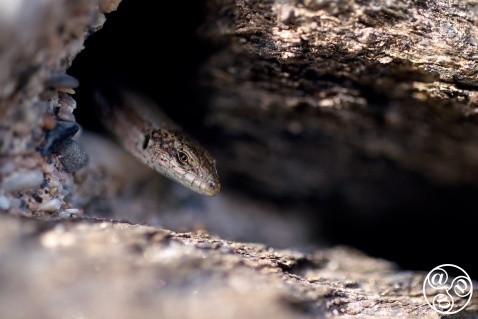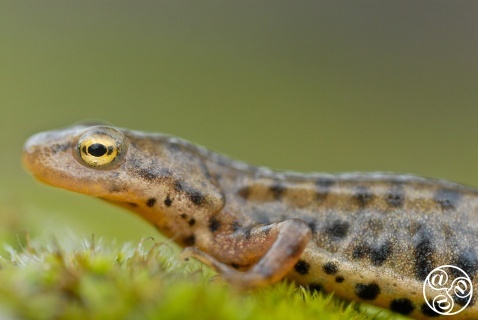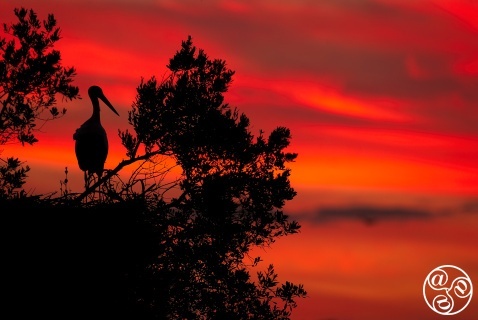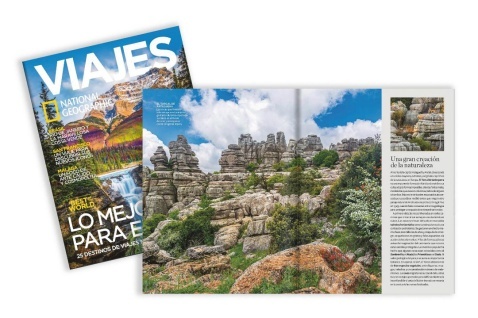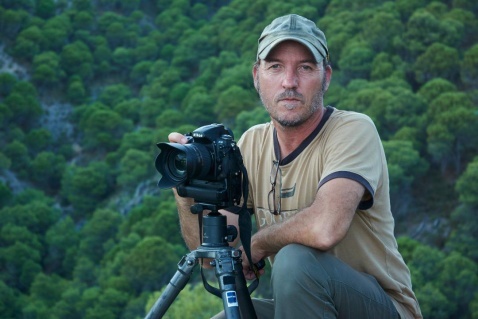
Marcos G. Meider at home in Andalucia |
|
Marcos G. Meider
Interview with nature photographer Marcos G. Meider
Marcos Meider is a professional photographer specialising in nature, wildlife and travel photography. He is based in Southern Spain, where he has lived since his childhood. Marcos has been capturing wildlife images since he was 8, when he had his first camera. Self-taught like many photographers, he took up photography as his profession on graduating.
Marcos combines his wildlife images with his own words to produce articles for various publishers and magazines. His images have been published worldwide across five continents, in countries such as Spain, the UK and many other European countries, as well as the USA, Russia, Japan, China, and Australia, and also various countries in South America.
Andalucia.com: What is your favourite pueblo blanco (white village)?
Marcos Meider: My favourite white villages are, without a doubt, Ronda and the towns in the Genal Valley that are surrounded by beautiful Mediterranean forest where cork oak trees are predominant in the landscape.
AC: What is your favourite festival?
MM: I am not a very religious person, but I must say that Holy Week is one of the most representative festivals or social events in Andalucia. I have a sort of admiration for its uniqueness and the aesthetics that it involves.
AC: Where do you go for a secret escape?
MM: There is a cork oak forest in the southern part of the Sierra de las Nieves National Park, between Marbella and Istán, which is a special place for me. This is mainly because of the pristine landscape, the degree of conservation, and the richness of its wildlife, and because time seems to stand still there... especially considering how close it is to the bustling coast.
AC: What is your best-loved beach/inland natural spot?
MM: Choosing just one is really difficult for me, but I would say the coast of Cadiz for its beaches, the area around Tarifa, Bolonia, Barbate and its estuaries. If I had to choose inland, it would be even more tricky – the Sierra de las Nieves, Doñana, Los Alcornocales, Cazorla, Sierra Morena, El Torcal de Antequera, and Fuente de Piedra all have something magical.
AC: What is your favourite cherished Andalucian tradition/custom?
MM: One of the traditions that I most enjoy is sitting around a table in the company of friends and family, enjoying a good meal and some nice wine. Or something as simple as going out for tapas.
AC: What is the best time of year in Andalucia for you, and where do you like to spend it?
MM: Any time of the year is good here in Andalucia, although in summer I would choose a destination near the coast, and if it is close to the Strait of Gibraltar, even better. But without a doubt, spring and autumn are the best time to visit any wooded or mountainous area in Andalucia, such as La Cañada del Cuerno in the Sierra de las Nieves.
AC: Do you have a favourite food ingredient or special dish?
MM: I love rice and all its variants, so a good paella is a dish that I really enjoy. Also fish and shellfish, but I am increasingly concerned about their sustainability.
AC: Tell us five words that describe what Andalucia means to you.
MM: Joy, colour, light, nature and tradition.
AC: What is your first memory of the natural world in Andalucia?
MM: Ever since I was a child, I have always had a close connection with nature. One of my favourite things to do was roaming around the countryside discovering the fauna and flora that surrounded me. I especially remember when I went to Cazorla, in Jaén province, for the first time, when I was 12 years old. That was more than 40 years ago and at that time it was a very wild and sparsely populated area. I went with my great friend, Cristian Rueda, a fantastic nature photographer who was in his twenties at the time, and I remember how wild it was when we got there. We spent days in the mountains without seeing anyone and eating around a campfire at night. We were surrounded by the sights and sounds of animals such as deer, badgers, owls and wild cats.
Another great experience for me was spending a whole week at the Doñana Natural Park Biological Station, when I was 14 years old. I went on field trips and expeditions with various biologists who were working on scientific projects in areas that were only accessible to scientists. I was able to visit spectacular natural areas, witness the lives of different species, and meet interesting people. It was on this trip that I saw my first Iberian lynx, when their numbers were very low, and scientists began to mark and track certain individuals using radio collars.
AC: What do you love most about being a nature/wildlife photographer?
MM: I love photography - I need to be out in contact with nature. For me it is like the air that we breathe. If I don't go out into the field, I feel like I am short of breath. For me, a bad day in the field will always be better than a good day at the office.
AC: What are you trying to communicate/achieve with your photos and videos?
MM: I am trying to show the beauty of nature, and the importance of the animals and plants that coexist with us on this planet. In addition, that we humans, also being elements of nature, have the duty and responsibility to preserve, and not destroy, it.
AC: What are the most important qualities of a nature photographer in your opinion?
MM: First, I would say to have a love for what you do and a total respect for nature. Don’t make the object of your desire, taking a picture of an animal or a plant, become more important than the welfare of the species.
If you think that you may cause a disturbance to an animal, then you should stop. You'll have another chance at another moment. A good dose of patience is also necessary. The technical part, photographically speaking, is the least important. You need to know your subject well and understand its natural history and behaviour patterns – that way, it will always be easier to photograph it, than if you know every type of photographic technique, but knowing nothing about your model.
AC: Can you tell us how you spend your day when you are on a photoshoot?
MM: I spend more time observing and exploring the terrain than taking photos, but it is because preparation and planning are key before pressing the shutter of the camera. It is what we call fieldcraft. Once I know what I have to do and where I have to place myself and also which equipment I need to use - let’s say setting up or building a hide, a sort of camouflaged tent from where to photograph fauna without being seen - and what photographic gear I need, that is when the photo session starts.
On most occasions I don't get the shot the first time, so I have to return and do several sessions in order to get the photos I'm looking for. Sometimes I can't even photograph what I was looking for, and I have to return home empty-handed.
AC: Can you share a memorable experience of being out and about, working in Andalucia?
MM: Choosing a single experience is difficult because I have had many, but there are many moments that I have enjoyed a lot, especially when an animal has been really close and I was able to enjoy its presence, photograph it without being seen, and then the animal has moved away quietly and carried on with its life as if nothing had happened.
Marcos’ top tips for nature photography
AC: Can you give us some recommendations for technical equipment? What do you use?
MM: Use only the equipment that you are going to need for the specific task at hand; do not get carried away trying to take unnecessary gear.
Sometimes you don't need a super-powerful telephoto lens to get a great photo - you can get spectacular results with a wide angle.
Being a nature photographer who covers a wide spectrum, from macro photography, through landscape, and specialising in wildlife and animals. I use lenses that range from 17 mm to almost 600 mm and high-tech cameras.
To be honest, this contradicts my first statement where I said you shouldn't be obsessed with equipment, but after so many years in the business I've learned exactly what I need and what I don't.
The important thing is to know what you want to achieve and what equipment you will need to achieve it. But think that apart from your photo gear, a sound idea, a good eye, and taking advantage of the resources you have at hand are all invaluable.
AC: Can you suggest some great spots in Andalucia for nature photographers to visit?
MM: Any place in Andalucia where you live or where you spend time surely offers good photographic possibilities, as you will be familiar with the environment and animals, but I can recommend good spots where you can take excellent photos and also have enjoyable experiences. The Sierra de las Nieves is a great place for mountain scenery or to enjoy spectacular flora such as the Spanish fir, as well as Sierra Nevada.
Fuente de Piedra and Doñana both offer extremely good opportunities for bird photography, especially waterfowl and birds that live in marshlands. In the case of Doñana you can also get some good opportunities to photograph mammals such as lynx, deer and wild boar.
El Torcal de Antequera is an excellent place to photograph the unique and spectacular landscape, together with the Spanish ibex, and also Sierra Morena with its star animal, the Iberian lynx. Los Alcornocales with its Mediterranean forest is another superb destination that you shouldn't miss.
AC: Can you tell us more about the photographic workshops/safaris that you organise?
MM: Although I spend a lot of time alone in the field working on my projects, I like to share my experiences with anyone who is interested in anything to do with nature and the natural environment.
For many years I have been writing articles for magazines to go with my photographs, or perhaps I should say reportages featuring my photographs where I also write the text. Actually my first connection with Andalucia.com was a feature on Sierra de las Nieves for the Andalucia Magazine in 1996.
I also supply photos requested by editorials and magazines such as BBC Wildlife, National Geographic and National Geographic Traveller.
In addition, I organise photographic tours and workshops where I take photographers to specific places so that they can enjoy a unique experience, or they can photograph particular species and places. Many of my clients come from abroad and want to photograph endemic species (those that are only found here) and I save them the time of having to look for them. I have had clients from the USA interested in photographing Bonelli's eagle, for example.
Those who are new to nature photography and want my guidance to help them learn can sign up for workshops that I organise for groups of photographers. For those who want a more exclusive and personal service, I also offer private one-to-one tuition.
A few years ago I embarked on a new project where, with along a team of highly competent people, we organise one of the most important nature photography contests on the international scene, called MontPhoto. This includes a three-day nature photography festival where we invite some of the most prestigious photographers in the world to tell us about their experiences, many of them working for renowned publications and organisations such as National Geographic and the BBC.
You can see Marcos’ photos at his website www.mgmeider.com.

